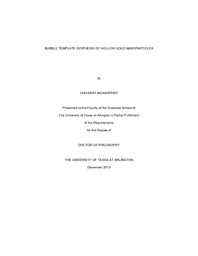
ATTENTION: The works hosted here are being migrated to a new repository that will consolidate resources, improve discoverability, and better show UTA's research impact on the global community. We will update authors as the migration progresses. Please see MavMatrix for more information.
Show simple item record
| dc.contributor.author | Muangphat, Chivarat | en_US |
| dc.date.accessioned | 2014-09-17T17:27:42Z | |
| dc.date.available | 2014-09-17T17:27:42Z | |
| dc.date.issued | 2014-09-17 | |
| dc.date.submitted | January 2013 | en_US |
| dc.identifier.other | DISS-12482 | en_US |
| dc.identifier.uri | http://hdl.handle.net/10106/24691 | |
| dc.description.abstract | Recently, a new synthesis method for creating hollow gold nanoparticles by using electrochemically hydrogen nanobubbles as a template was discovered in our research group. Hollow gold nanoparticles with well-controlled, tunable dimension and morphology can be synthesized using various synthesis conditions. Such hollow gold nanoparticles exhibit unique optical properties that can be tuned by changing the nanoparticle structures. The objective of this study is to understand the formation mechanism of hollow gold nanoparticles synthesized using bubble template synthesis method. The synthesis process can be divided into two main processes: the formation of hydrogen nanobubble and the reduction of gold ions on the hydrogen nanobubble surface. Both processes were observed by in-situ and ex-situ study techniques. Phase Sensitive Interferometry Technique (PSI) is employed for in-situ monitoring the formation of hollow gold nanoparticles. PSI is a very sensitive in-situ technique for detecting sub-nanometer change of thickness on a transparent substrate. Our results demonstrate PSI can be used to probe an electrochemical process without any interference with the process. Using PSI, the formation of hydrogen nanobubble and the reduction of gold ion on hydrogen nanobubble surface have been in-situ detected by monitoring the modulation shifted due to the optical path length and the amplitude change caused by refractive index change. These results confirmed our hypothesis that the hydrogen nanobubbles act as templates for the formation of hollow gold nanoparticles. To further test the ability of PSI for in-situ probing an electrodeposition process, PSI has been used to monitoring Underpotential Deposition (UPD) of copper on gold surface. In an UPD process, a single layer of atoms can be electrochemically deposited onto another metal surface. The PSI technique is more suitable than other characterization techniques that have been studied before. Since PSI can probe an UPD process conducted in a normal electrochemical cell and does not interfere with the process. We have successfully detected the formation of one monolayer of copper on gold-coated mica substrate using PSI. The effect of synthesis parameters on the size, shell thickness and morphology of hollow gold nanoparticles has been ex-situ studied using transmission electron microscopy (TEM) and scanning electron microscopy (SEM). It has been found that, the number of hydrogen nanobubbles increases as the concentration of hydrogen evolution enhancer, overpotential, or deposition time increases. On the other hand, the size of hydrogen nanobubbles significantly decreases with increasing of overpotential or decreasing of pore size of the membrane or hydrogen evolution enhancer concentration. Moreover, the number of gold nanoparticles increases while the size of gold nanoparticles decreases with the increase of applied potential or gold ion concentration, so the number of gold nanoparticles decreases while the size of gold nanoparticles increases as the stabilizer concentration increases. Also, the porosity of gold shell changes while varying either the concentration of gold ion or the concentration of stabilizer. | en_US |
| dc.description.sponsorship | Hao, Yaowu | en_US |
| dc.language.iso | en | en_US |
| dc.publisher | Materials Science & Engineering | en_US |
| dc.title | Bubble Template Synthesis Of Hollow Gold Nanoparticle | en_US |
| dc.type | Ph.D. | en_US |
| dc.contributor.committeeChair | Hao, Yaowu | en_US |
| dc.degree.department | Materials Science & Engineering | en_US |
| dc.degree.discipline | Materials Science & Engineering | en_US |
| dc.degree.grantor | University of Texas at Arlington | en_US |
| dc.degree.level | doctoral | en_US |
| dc.degree.name | Ph.D. | en_US |
Files in this item
- Name:
- Muangphat_uta_2502D_12482.pdf
- Size:
- 48.64Mb
- Format:
- PDF
This item appears in the following Collection(s)
Show simple item record


